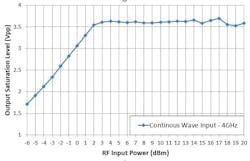How RF FDAs Enhance Test Systems with RF Sampling ADCs
What you’ll learn:
- How to use DC-coupling for RF sampling ADCs.
- How to improve system linearity.
Higher data rates in wireless communication systems and the use of narrower pulses in radars to resolve close targets require greater performance and bandwidth requirements in test and measurement instruments. Radio-frequency (RF) test-and-measurement instruments such as high-bandwidth oscilloscopes and RF digitizers use RF sampling analog-to-digital converters (ADCs) that simultaneously digitize signals from DC to multiple gigahertz.
RF sampling ADCs replace mixers followed by narrowband ADCs reduces system complexity and improves the performance of wideband test and measurement instruments, radars, and wireless transceivers.
Designers typically use a single-ended gain block in cascade with a passive balun to drive RF sampling ADCs. However, there are drawbacks to this approach that limit the achievable performance. In this article, we discuss these drawbacks and illustrate how an RF fully differential amplifier (FDA) can help you maximize the performance of your RF sampling ADCs.
Introduction to DC-Coupling in RF Sampling ADCs
RF sampling ADCs accept differential inputs to reject common-mode noise and interference and improve second-order distortion. Because of their wide bandwidth, system designers use transformer-based passive baluns to convert single-ended RF signals to differential signals to drive RF sampling ADCs.
However, passive baluns operate from hundreds of kilohertz or tens of megahertz on the low-frequency side based on the bandwidth that they support. Thus, the use of a passive balun to drive RF sampling ADCs in test and measurement instruments limits the lowest frequency that can be digitized.
The DC-coupled TRF1305 RF FDA developed by Texas Instruments performs single-ended to differential conversion with a usable large-signal bandwidth that covers DC to 6.5 GHz, while providing gain. Figure 1 shows the TRF1305 RF FDA driving an RF sampling ADC in a DC-coupled application. RF sampling ADCs have a narrow input common-mode range, and operation outside this common-mode range degrades ADC performance.
Single or split flexible power supplies, along with output common-mode control, make it easier to match the TRF1305’s output common mode to the ADC’s input common mode. Such features make this amplifier versatile in DC-coupled RF test and measurement instruments like high-bandwidth oscilloscopes, arbitrary waveform generators and RF digitizers.
Improving System Linearity in Wideband Systems
Nonlinearity of components in a signal chain affects the detection of small signals in the presence of large interfering signals. Second-order nonlinearity isn’t very important in narrowband systems because the nonlinearity created falls outside the frequency band of interest and is generally filtered out.
However, such is not the case with wideband systems. When the input signal bandwidth covers multiple octaves, the second-order nonlinearity of the signal appears in band. For example, consider an RF sampling ADC used with an RF bandwidth of 0.5 to 2 GHz. The second-order nonlinearity of a signal at 0.5 GHz occurs at 1 GHz, which is twice the frequency. But this second-order nonlinearity is less than the 2-GHz maximum frequency of interest and must be minimized since it’s not possible to filter it out.
RF sampling ADCs are designed to minimize second-order nonlinearity when their inputs are driven by balanced differential signals. Wideband passive baluns may have poor gain and phase imbalance on their differential output, leading to unbalanced signaling and degradation of the linearity performance of ADCs.1 And RF gain blocks used to amplify the signal before the passive balun have poor second-order nonlinearity given their single-ended operation.
RF FDAs such as the TRF1305 and TRF1208 incorporate feedback techniques that help achieve improved gain and phase imbalance on the differential outputs. The differential nature of the amplifiers minimizes second-order distortion and enhances linearity of the overall system while providing signal amplification.
Protecting ADCs from Damage in High-Power Applications
In many test-and-measurement and aerospace and defense systems, the user inputs are unknown. The RF ADCs at the core of these systems are sensitive to high power levels and overdrive. These ADCs also tend to be high performance and are often one of the most expensive components in the signal chain. That’s why it’s important to carefully design the signal chain so that the preceding components don’t damage the ADC. RF FDAs are designed to be linear when driving RF sampling ADCs to full scale.
Figure 2 shows the output saturation level when the TRF1208 FDA is overloaded with continuous-wave input at 4 GHz. The TRF1208 has 16 dB of gain and its output saturates to 3.6 V p-p at about 2 dBm of input power into the FDA. Therefore, using RF FDAs to drive the ADCs inherently limits power during an overload caused by output clipping.
Designing an attenuator pad between the FDA and the ADC bounds the voltage swing at the ADC pins (Fig. 3). This protects the ADC from damage and simplifies system design considerations while offering more design flexibility.
Conclusion: Streamlining RF System Designs
The advancement and adoption of RF sampling ADCs simplifies the system architecture of RF test-and-measurement instruments by reducing the number of components and board size. RF FDAs such as the TRF1305 tailored for ADC drive applications further simplify system architectures with single-ended to differential conversion of signals from DC to over 6.5 GHz.
The use of wideband RF FDAs paired with RF sampling ADCs in receive signal chains offers enhanced system performance while lowering component count, board size, and system cost.
Reference
1. Reeder, Rob. “A close look at active vs. passive RF converter front ends.” Planet Analog, Jan. 26, 2022.





